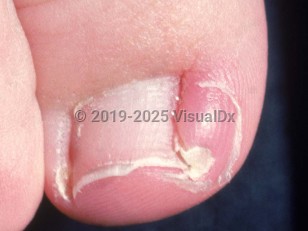Ingrown toenail - Nail and Distal Digit
Alerts and Notices
Important News & Links
Synopsis

Lateral ingrown toenails are the most common type, especially in children and young adults. The nail becomes embedded into one or both lateral nail folds, with a nail spicule that breaks the epidermis of the lateral groove with subsequent inflammatory reaction and pain. Cutting the spicule aggravates the condition by causing a new, more proximal spicule to form. In time, granulation tissue may develop with concomitant oozing, bleeding, and secondary infection. The condition may be precipitated by improper nail cutting, plantar hyperhidrosis, trauma, and anatomical foot abnormalities.
The second, and much less common, type of ingrown toenail occurs distally. Normally, there is a natural counter pressure from the nail plate to the underlying tissue. Nail plate avulsion or traumatic nail shedding cause a loss of counter pressure, causing a bulbous extremity. The newly formed nail abuts this distal wall, which interferes with its normal growth. A deep transversal horn fills the distal groove and results in the ingrown nail and pain.
Codes
L60.0 – Ingrowing nail
SNOMEDCT:
400200009 – Ingrown toenail
Look For
Subscription Required
Diagnostic Pearls
Subscription Required
Differential Diagnosis & Pitfalls

Subscription Required
Best Tests
Subscription Required
Management Pearls
Subscription Required
Therapy
Subscription Required
Drug Reaction Data
Subscription Required
References
Subscription Required
Last Updated:04/09/2017
 Patient Information for Ingrown toenail - Nail and Distal Digit
Patient Information for Ingrown toenail - Nail and Distal Digit- Improve treatment compliance
- Reduce after-hours questions
- Increase patient engagement and satisfaction
- Written in clear, easy-to-understand language. No confusing jargon.
- Available in English and Spanish
- Print out or email directly to your patient


